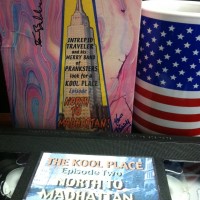Our Favorite Things: Documentaries
- Details
- Published on Monday, 24 June 2013 10:59
- Written by Kevin Kizer
Ever since Michael Moore burst on the scene with the 1989 film “Roger and Me” about General Motors and the decline of Flint, Mich., we seem to be in a golden age of documentaries. This week we take a look at some of our favorites.
Now, this is not intended to be a complete list of the best documentaries ever – just the ones we really, really like. We left off some of the bigger one from recent years (“Super Size Me”, “Fahrenheit 911”, “Enron: The Smartest Guys in the Room" and the “Paradise Lost” series). But some of our favorites are definitely some of the best. And hopefully some of them will become (or already are) your favorites too. Enjoy!
By Bill Knight, Kevin Kizer, Steven Streight, Terry Towery and Mike Cameron
“Harvest of Shame” – 1960
While documentaries have experienced increased popularity in the last decade, my favorite remains Edward R. Murrow’s 1960 expose of migrant workers’ lives and labor, “Harvest of Shame,” and it may be even more valuable now for providing a glimpse of changes in the economy, politics and journalism in the last 53 years.
First, the 55-minute documentary – telecast as part of “CBS Reports” just after Thanksgiving that year – reveals the overlooked reality of how Americans’ food was picked and processed for consumption, but the poignant conversations with migrant workers show that exploited labor pool to be much more diverse than 21st century viewers would probably expect. There are whites and African-Americans, military veterans and women with kids, all commenting on their plight, whereas today the subjects would no doubt be predominantly Hispanic.
Next, while the agribusiness voices speak in a predictable boilerplate that sound remarkably like current Chamber of Commerce points of view, government perspective is startling in its attentiveness, especially Republican President Dwight D. Eisenhower’s Labor Secretary, James P. Mitchell. Confronted with migrant workers’ little-known or conveniently ignored wages, hours and working conditions – and living conditions, Mitchell seized the opportunity and helped shepherd through Capitol Hill reforms to alleviate the worst circumstances the farm workers suffered. The honest and brave cabinet member is so forthright, in fact, many will realize that few Democrats today would take such a stand, much less Republicans.
Finally, the journalism anchored by the legendary Murrow helps the 2013 audience realize an absence of what commercial networks used to routinely provide in the way of public-affairs reporting. Besides Murrow – in his best-known and last documentary for CBS – “Harvest of Shame” benefits from the steady hand of executive producer Fred Friendly and the hands-on talent of producer and field reporter David Lowe, who conducts most of the location interviews with struggling Americans, who seem right out of a Dust Bowl scene if not a Grant Wood painting.
Compared to what passes for investigative reporting on today’s TV-cable-satellite-Internet universe – with hundreds of more outlets available to feature such journalism – “Harvest of Shame” reminds news consumers of what was great, and what could be great again.
- Bill Knight
You can watch the entire documentary on YouTube:
“Marjoe” – 1972
“Just as sure as you’re listening to me! Just as sure as you’re listening to an eight-year old voice! Just as sure as you’re playing a record! It’s just as sure that you’re going to go to hell if you are not saved!” Those were the opening words of a 1950’s record from MarJoe Gortner, who by the age of eight was already a well-seasoned evangelical and the world’s youngest ordained minister.
During the ‘50s and ‘60s, Little MarJoe was taken around the country by his parents, whipping religious crowds into frenzies while convincing them to part with their hard-earned money. He drew crowds everywhere he went because of his ability to deliver dramatic, fire-and-brimstone sermons at a very young age. By the time he was a teen, his parents had amassed upwards of three million dollars. It all ended when his dad left the family and took off with the money. That’s when MarJoe dropped out of the evangelical movement and joined the counterculture of the ‘60s.
Later in the decade, desperate for money, MarJoe hit the preaching circuit once more but his conscience finally got to him. So he decided to make one final tour – this time with a film crew on hand with the goal of exposing the tricks of ministers who had become rich off the faithful. The documentary won an Academy Award in 1972 and is as jaw-dropping to watch today as it was when it came out 40 years ago.
- Kevin Kizer
Watch the whole documentary on YouTube:
Here are a few excerpts:
“Ken Kesey Intrepid Traveler and his Merry Band of Pranksters Look for a Cool Place: North to Madhattan” – 1995
This isn’t so much a documentary as just a batch of original footage of Ken Kesey and his Merry Band of Pranksters making their way to “Madhattan” in 1964 to celebrate the publication of his second novel, “Sometime a Great Notion” and to visit the World’s Fair. They bought a bus – the now famous Further -- painted it, outfitted it with a sound system, and hooked up movie cameras and tape recorders to film and record everything along the way. The bus was driven by none other than Neil Cassady, who had been immortalized in “On the Road” by Jack Kerouac. In fact, during their trip they stop to see Kerouac, just a year away from death, for a very un-happy reunion. They also stop by Timothy Leary’s rambling mansion in Millbrook, NY, where they run across Allen Ginsberg, among others.
The footage sat idle for fifty years until Kesey and fellow Prankster Ken Babbs published it in the ‘90s. It finally got a theatrical release in 2005 and is available online. In 1996, I ordered a copy of the footage from Kesey’s website and was thrilled to discover that my copy (a VHS) was signed by the author himself. In fact, while taking a second look at the packaging for this story, we discovered the video box itself was dip-painted to achieve its psychedelic look.
- Kevin Kizer
It’s hard to find any of the footage on YouTube, but you can find out more about the documentary here.
"I Dream of Wires" – 2013
This is an upcoming, independent documentary film about the phenomenal resurgence of the modular synthesizer — exploring the passions, obsessions and dreams of people who have dedicated part of their lives to this esoteric electronic music machine. It is written and directed by Robert Fantinatto with Jason Amm (Ghostly International recording artist Solvent) serving as producer and co-writer.
Inventors, musicians and enthusiasts are interviewed about their relationship with the modular synthesizer — for many, it's an all-consuming passion. Established musicians such as Trent Reznor (Nine Inch Nails), Carl Craig and John Foxx show off their systems and explain why they opt to use this volatile but ultimately rewarding technology. Meanwhile, a new generation of dance and electronica artists including Clark, James Holden and Factory Floor explains why they've stepped away from laptops to embrace the sound and physicality of modular synthesizers. Innovative companies like Modcan and Doepfer, driven by a desire to revive modular synthesizers, discuss how they planted the seeds that have now grown into a major cottage industry. What started out as a vintage-revival scene in the '90s has grown into an underground phenomenon with a growing market of modular obsessives craving ever more wild and innovative sounds and interfaces. Today, the modular synthesizer is no longer an esoteric curiosity or even a mere music instrument — it is an essential tool for radical new sounds and a bona fide subculture.
- Mike Cameron
Watch the extended trailer:
Other Favorites:
“American Movie” – 1999 (KK)
About one man’s attempt to make a horror film.
“Inventor of the Synthesizer: Moog” – 2004 (MC)
About the man who invented the synthesizer.
“Hearts of Darkness: A Filmmaker’s Apocalypse” – 1991 (KK)
About Francis Ford Coppola’s struggle to film “Apocalypse Now”.
“Roger and Me” – 1989 (KK)
About one man’s attempt to confront the owner of General Motors.
“The Wild and Wonderful Whites of West Virginia” – 2009 (MC)
About the death of the patriarch of a rough-and-tumble family West Virginia family.
“When the Levees Broke: A Requiem in Four Parts” – 2006 (SS)
About the devastation of New Orleans during (and after) Hurricane Katrina.
“Eyes on the Prize” – 1987 (TT)
About the African-American Civil Rights movement from 1954 to 1985.
"Food Inc." – 2009 (SS)
About the power and of the industrial food industry and consumers who are turning the tables.
"Don't Look Back" – 1967 (SS)
About the rise of Bob Dylan and featuring one of the most iconic music videos.
"No Direction Home" – 2005 (SS)
About the life and times of Dylan by Martin Scorsese.
"Eat the Document" – 1972 (SS)
About Dylan’s tour in 1966 with The Hawks (who later became The Band)
“The Source” – 1999 (KK)
About the rise of the writers of the Beat Generation, with dramatic readings by John Turturro (Ginsberg), Johnny Depp (Kerouac) and Dennis Hopper (Burroughs).
"All Watched Over By Machines of Loving Grace" – 2011 (SS)
About how we have been colonized by the machines we’ve built.
"The Atomic Cafe" – 1982 (SS/KK)
About the history of the atom.
“An Ox’s Tale: The John Entwistle Story” – 2006 (KK)
About the greatest bass guitar player in rock-n-roll history.


















































